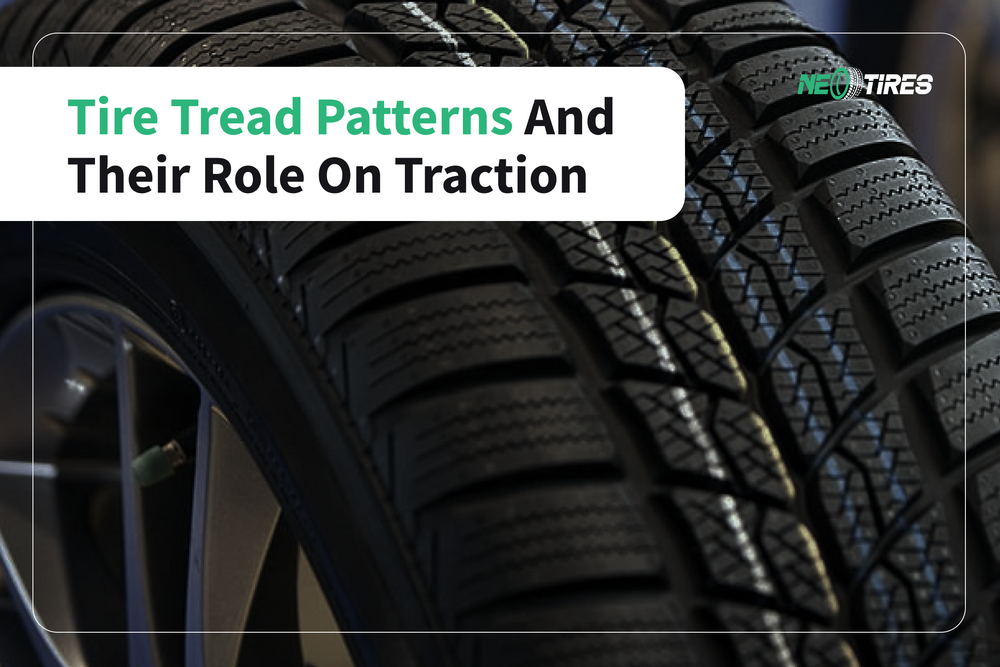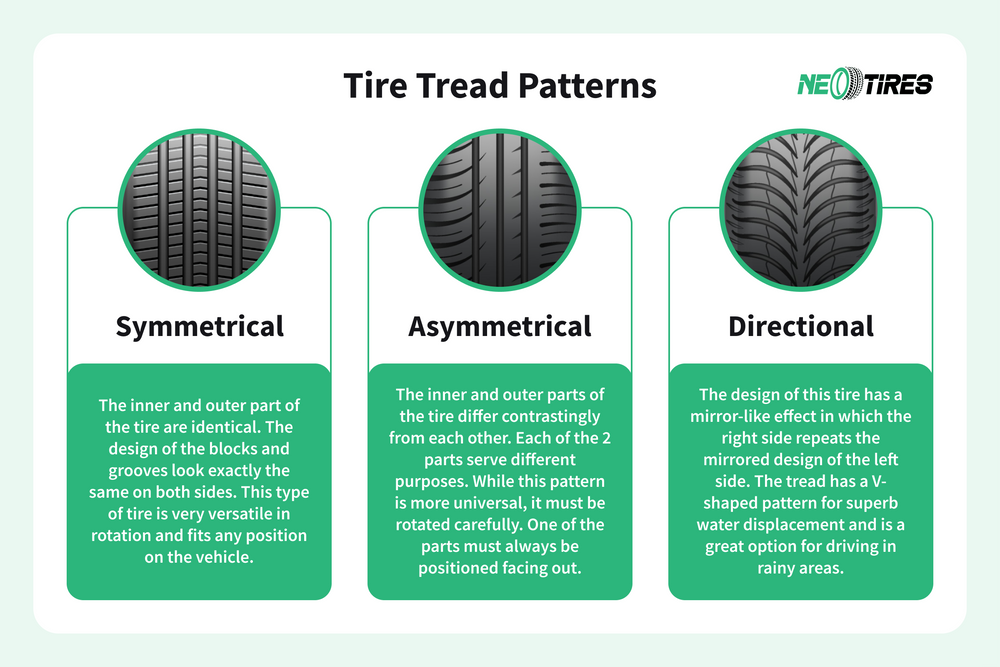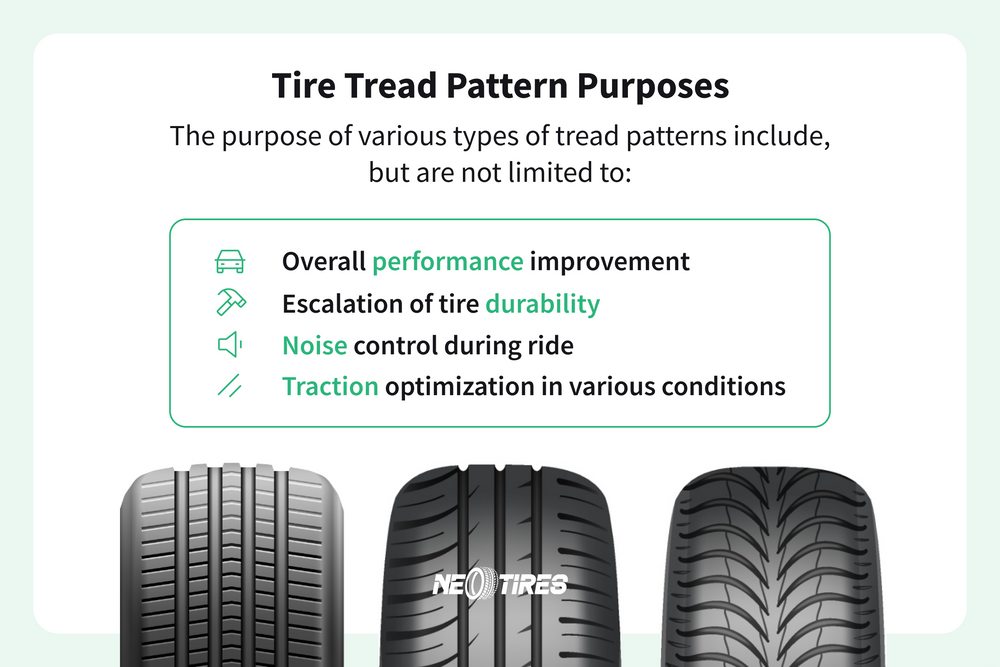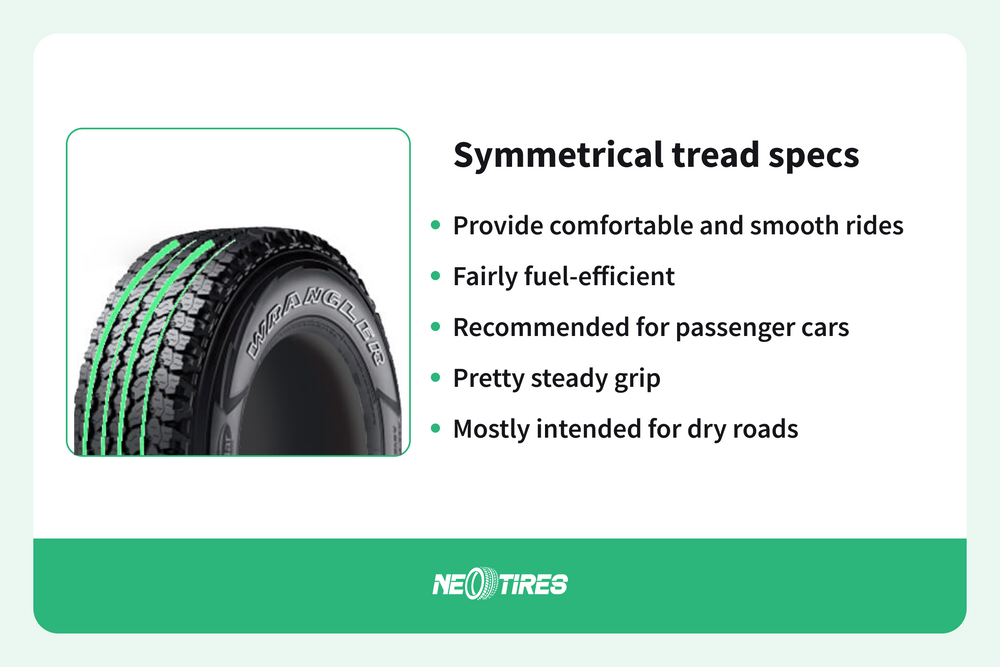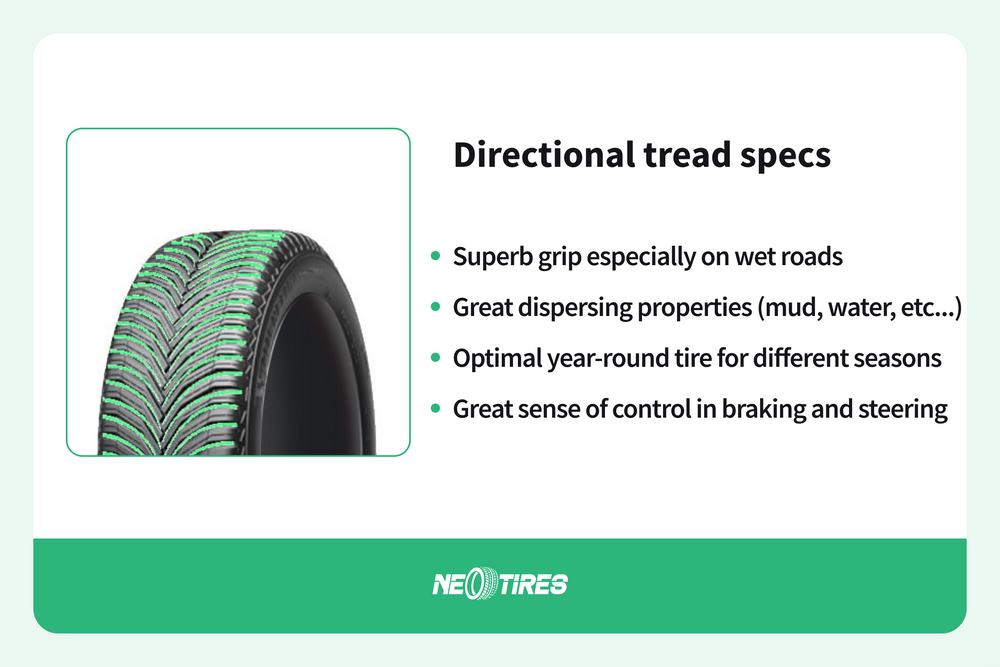Hello to all car enthusiasts!
Today I will talk about everything that tire tread means and how it influences the performance of the car. You know for sure that tires are some of the most crucial "accessories" of the car that directly impact the way it behaves on the road. In this context, whenever you feel that the handling of your vehicle becomes poorer, or the acceleration/braking ability becomes weaker, check the tires first.
While there are many aspects related to tires that influence the car's traction (such as wheel alignment or tire balance), the tire tread pattern is no less essential. What is the specificity of different tread patterns? What are they needed for? And how do they influence the driving experience? We will cover all these topics in the following article. I propose that we get down to business immediately because we have a lot of work to do.
What Is A Tread Pattern?
First things first, that is, let's start with the explanatory definition of what "tire tread pattern" means. The term directly refers to the rubber that wraps around the tire and interacts directly with the road surface. This rubber portion comes with specific patterns that usually have different designs of snow or rain grooves and ridges. These ridges and grooves aren't just "for beauty"; their purpose is to improve the stability of the vehicle, as well as to increase grip on different types of roads.
In such a context, manufacturers produce different types of grooves and ridges depending on the season (summer/winter/all seasons) as well as depending on the road's unevenness. Now that you know the definition of the term, let's move on to the next question: the tire tread purposes.
What Is The Main Purpose Of Tire Tread Patterns?
First of all, you must know that different tire treads do not have a single function, but a multitude of functions. Each design of your tires serves a certain purpose. Respectively, it is good to know what exactly you are looking for in your tires in order to choose the patterns that suit your needs.
In general terms, the essential purpose of tire treads is to remove water and control hydroplaning, road impurities, and small particles from their path, to provide the smoothest possible contact with the road surface. Consequently, the better the tread's ability to remove those obstacles, the more optimal the driving experience. The difference you will feel with a set of good tires with optimal tread patterns consists of the following benefits:
- improved performance with every turn, acceleration, and braking;
- more promising durability for tires;
- reduced noise from outside the car;
- better traction;
Let's take them one by one and understand better how exactly tire tread patterns influence each of these aspects.
Improved Performance
You certainly want an agile vehicle when it comes to its ability to respond to braking, especially on wet roads, acceleration, and overall handling. In this context, the patterns of your tire treads are responsible for the way your car maintains stability on the road in any of these scenarios. Tires with high-quality tread patterns have a greater potential to reduce the risk of hydroplaning or sliding compared to low-quality tires.
In the same context, the vehicle gets a more responsive braking ability, which significantly reduces the risks of major accidents. Thanks to the improved grip of the tires with better tread patterns, the vehicle promises a much safer performance from stability and traffic safety points of view.
Noise Reduction
Very few people know that in fact, tire tread patterns can be a good or a bad noise inhibitor. Manufacturers of high-performance tires pay more attention to the architecture of modern tires. They collaborate with physicists who help them create patterns that could block the sound from reaching the car cabin.
Through certain physical processes, the waves of external sounds pass inside the car through the wheels. Certain types of tread patterns have such an architecture that the waves return to the external environment, failing to penetrate the vehicle's transmission. In this context, the noise in your car may be generated specifically by some wrong tires. So, get your car a checkup and opt for the quietest tires.
Tire Durability
It is unbelievable, but specialists in the field confirm the fact that the tire treads actually contribute a lot to the durability and general condition of the tires. The explanation lies in the fact that the treads help the weight to be distributed equally over the entire tire. In the same context, the treads help the different roads, especially the aggressive ones, to be less stressful for the tires and the vehicle. With minimized stress, the entire traction system is kept in a better condition providing long-lasting resistance and performance.
Traction
Here we are at the most important benefit of tire tread patterns: improved traction. As I mentioned before, their primary role is to remove the rocky and watery obstacles from their path to establish a "clean" contact with the road surface. At the same time, the traction of a vehicle is always better when it travels on a smooth road.
But, taking into account that not all roads are even remotely smooth, namely tire patterns are the factor that provides this smoothness as much as possible, removing road impurities. The road smoothness directly depends on the structure of the chosen pattern. The higher the quality of the tread pattern, the more "silky" your driving experience will be.
A no less important aspect refers to the car grip that a qualitative tire tread pattern can offer. It is very important to look for tires that have a contact area as large as possible between the tires and the road. In such circumstances, the tread greatly improves the grip. As you already know, a better grip is the key to stable and high-performance car handling by eliminating skidding, sliding, or losing control.
I hope that now you realize the role of tire tread patterns and how important they are for the safety of your car. Never skimp on quality tire treads, because they are directly proportional to your safe and pleasant driving experience.
Different Types Of Tire Tread Patterns
I assume that you are also curious to know what the types of tire patterns are. Earlier, I included an image showing three main types of tread patterns. In fact, there are also several sub-types, and I will give you some tips on how to choose the right type for your vehicle. Keep in mind that choosing a tread pattern according to your needs is just as important as choosing your tires according to the season.
Symmetrical Tire Tread Pattern
This type of tire tread is very welcome for passenger cars. These are the tire treads of choice when the driver wants a calm, smooth, and comfortable ride. The specific design of symmetrical tire treads consists of the fact that they have the same tread type both on the inner and the outer parts.
These tread patterns usually provide quite promising stability and optimize tire fuel efficiency. They are not the most suitable for high-performance cars. As for passenger cars, they provide a fairly promising and steady grip. Symmetrical treads' shortcoming lies in the fact that they are not quite effective in mud and water conditions. A good example of an optimal symmetrical tire is this Yokohama S.Drive tire.
Asymmetrical Tire Tread Pattern
Unlike their symmetrical counterparts, asymmetrical tire patterns come with 2 designs. You will notice the different look on the inner and outer half of the rubber surface. This design approach actually has an explanation behind it and serves a certain purpose.
The purpose of the inner tread is to drive water away from its path. Respectively, this pattern is welcome in avoiding vehicle hydroplaning. On the other hand, the outer tread design has an aggressive architecture of ridges and grooves. The purpose of this architecture is to significantly improve the vehicle's grip in fast reaction circumstances such as cornering, acceleration, or sudden braking.
As you can deduce, asymmetrical tire patterns make a beautiful couple with performance cars. At the same time, they are a good option for wet conditions. One such tire is the Hankook Ventus model.
Directional Tire Tread Pattern
This type of pattern is quite popular among car lovers due to the sustainable grip it offers. As the name suggests, this type of pattern works best when cars go in one direction (the other types of tires are bi-directional, as a rule). The design of the tread is reminiscent of the "V" letter shape.
This shape significantly improves the ability to remove mud, water, and other types of obstacles. Accordingly, a directional tire tread pattern is a very promising option for roads that can get you swamped, as well as for different seasons. A good example is the Michelin CrossClimate SUV tire.
The Rib-Shaped Tire Tread Pattern
As a general rule, this type of tire pattern is a recommended option for hard roads, such as tarmac. Due to its design, this type of pattern provides the vehicle with fairly promising stability and a greater sense of control over the steering wheel. At the same time, rib-shaped tread patterns have a reduced rolling resistance, which is a key factor that directly influences tire fuel consumption.
So, a rib-shaped tire tread pattern is one of the most fuel-efficient types of tires. In most cases, this type of pattern is suitable for high-performance cars that drive predominantly on tarmac or concrete surfaces.
Regarding the design specifics, this type of tire comes with a rib-shaped tread on the entire circumference of the tire. You can see different types of grooves on them, including straight lines or S-type voids. One such tire is the Kumho Crugen KL 33.
Lug-Shaped Tire Tread Pattern
These types of tires are predominantly good for big vehicles such as 4×4 cars. Due to their structure, they ensure increased traction. Their design comes as a series of grooves all aligned in a parallel position to each other. At the same time, tread ridges have a perpendicular position to the tire circumference.
This type of tire enjoys a good impression among lovers of cars with strong traction. It provides a great grip, especially in agile conditions such as braking and accelerating the vehicle.
Mixed Rib-Lug Tire Tread Pattern
This tire option is somehow a mixed pattern between the previous type and the rib-shaped one. This means that we will see in them the same S-shaped voids and lug-shaped grooves in perpendicular positions. The cars that require this type of tire tread are those with large and tall bodies such as buses or trucks. These tires perform greatly in conditions of dirt, mold, and water, removing all the obstacles in their way. Last, but not least, the mixed rib-lug tread pattern is one of the most performing when it comes to agile braking.
Which Tire Tread Pattern Is The Best?
Now you know about different types of tire patterns and how they influence the way your car performs. At the same time, it is not enough to know these aspects. You have to know what to draw attention to when you choose them so that your car harmonizes with them perfectly. The correct tire pattern choice contributes to the fact that your car is much safer on long travels and in extreme conditions.
Apart from safety on the road, tire patterns contribute beneficially to your comfort during the ride. And this is a nice bonus for any driver. So what should you pay attention to?
The first thing to consider is the condition of the roads you usually travel on. What characterizes them? Snow? Mud? High humidity? Dryness? Rockiness? All-terrain conditions? By answering this question, you can guess what type of tire patterns you need.
The second essential aspect is the type of car on which you will mount the new tires. If you are the owner of a sports car, you will definitely need tread patterns that ensure a perfect grip during acceleration, braking, and turning. Alternatively, a symmetric tread pattern will perfectly do for a passenger car.
The third criterion of influence is the style in which you prefer to drive your vehicle. If you love to feel the power of your engine and drive in a high-performance way, opt for directional and asymmetrical treads.
Tire Tread Patterns: FAQs
Is It OK to Have Different Tread Patterns?
Each tread pattern has its purpose and mechanism of action. Some are specially oriented towards dry traction and grip, others - towards wet performance, and the 3rd category is a combination of the first 2. Mixing tread patterns is not a good idea because a performance conflict may occur. Traction, handling, and grip can become unstable, and unintuitive and therefore can put the driver's safety at risk.
Are Different Tread Patterns Illegal?
The law does not somehow regulate the aspect of tire tread patterns. So, having different tread patterns does not go against the law. What is illegal in some states is tread pattern wearing more than 2/32''. So, technically, drivers can use different tread patterns but they must be aware of the potential consequences and risks. Different patterns affect the performance of the tires, generate irregular wear, and put the driver's safety at risk. In exceptional cases, when it is not possible to mount the same tread, experts recommend mounting at least the same pattern on the same axle. Either way, this combination must be exclusively a temporary measure.
Why Do Tires Have Patterns?
Tire design does not have an exclusively aesthetic role. It is specially built to strategically improve tire performance in various road and weather conditions. For example, drivers who live in wet areas with frequent rains need tires with special grooves and channels to evacuate water quickly and efficiently. This helps to improve grip and traction as well as to reduce the risk of hydroplaning.
Why Do F1 Tires Have No Tread?
Formula 1 tires are oriented towards superior performance on smooth roads. Treadless tires deliver impressive grip on dry roads and superior stability, especially at high speed. These criteria are fundamental for Formula 1 racing. These tires do not need tractional capabilities for snow or uneven roads simply because they are not meant for such conditions. The best way to meet Formula 1 performance levels is to use treadless tires which offer the best grip, tenacity, and stability when racing at the maximum limit. As for the rainy, wet conditions, F1 drivers usually switch to tires with some tread specially designed to meet both ultimate performance and wet stability.
What Tires Have No Tread Pattern?
Tires without tread are used in professional racing environments only. These are also called slick tires and their use in common driving conditions is not recommended. Slick tires are not reliable for general use because they do not have the necessary rubber and tread to deal with ordinary, irregular roads full of obstacles. So, these can be dangerous and put the safety of drivers at risk.
Why Trust Us?
Neotires is not just a dealer that offers great tire deals. We have a team of enthusiasts and professionals who offer superior quality services and products to their customers. Each member of the team has extensive experience in the vehicle and tire industry. This experience helps us to provide the best driving tips, tire maintenance techniques, the best mechanical service, and reliable information about everything that tires mean.
We collaborate with the most reputable tire makers to offer customers a wide variety of products for any budget, without sacrificing quality. At the same time, we are constantly developing and training in this industry to keep up with innovations, market trends, and new technologies. We love to review tires, compare them, test them, and share all we know about them with our customers. We have fun here at Neotires, while we learn, grow, evolve, and become a reliable partner for all drivers out there.
Bottom Line
Tire tread patterns have a much greater influence on the performance of your car than you might have imagined. Always keep in mind the fact that their primary purpose is to provide vehicle traction on various road surfaces. Their working mechanism consists of removing various road barriers such as mud, water, snow, and similar materials.
They achieve this through different types of grooves and ridges, the structure of which contributes to the primary purpose of the tire tread. Following the removal of all barriers on the road surface, the grip between the tire and the road becomes significantly optimized.
Taking all these aspects into account, it is a bad idea to buy tires without taking into account their tread patterns. If you encounter difficulties in choosing them correctly, call a technician. But never make the mistake of mounting tires with treads unsuitable for your car type and for the circumstances in which you usually ride.




